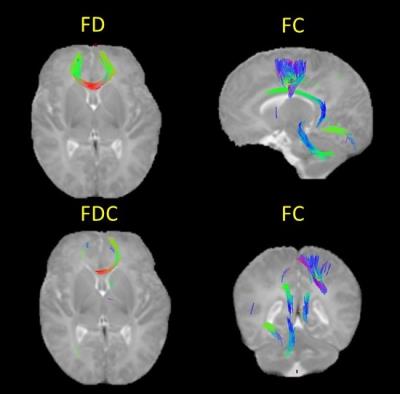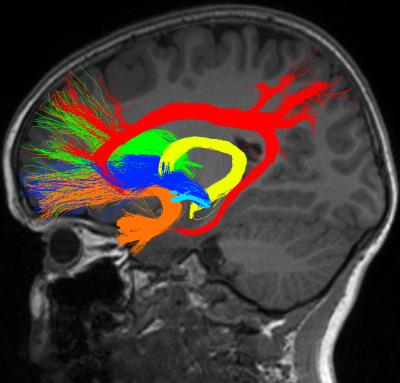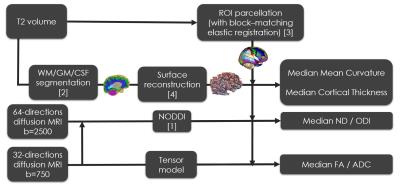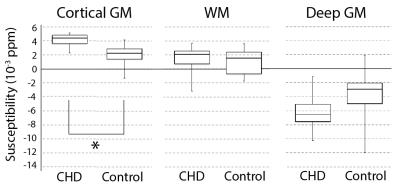Wednesday, 26 April 2017
| Room 310 |
16:15 - 18:15 |
Moderators: Chris Smyser, Duan Xu |
Slack Channel: #s_neuro
Session Number: O10
16:15
|
0892.
 |
Fixel-based morphometry detects alterations in specific fibres in association with preterm birth: a proof-of-concept study. 
Manuel Blesa, Ahmed Serag, Devasuda Anblagan, Emma Telford, Sarah Sparrow, Scott Semple, Mark Bastin, James Boardman
Preterm birth is closely associated with diffuse white matter injury which contributes to long term neurocognitive impairment among survivors. Fixel-based analysis (FBA) is the study of specific fibre populations within a voxel; it provides measures of fibre bundle morphology by combining information about fibre density with structure. In this work, we applied FBA to neonatal dMRI data and provide proof-of-concept that fibre density and fibre bundle cross section may be useful measures for evaluating alterations to brain development associated with preterm birth.
|
16:27
|
0893.
 |
Characterising white matter tracts of the limbic system and neurodevelopmental outcomes in children born very preterm 
Claire Kelly, Peter Anderson, Jenny Pham, Thanh Nguyen, Malcolm Cooper, Andrea Murray, Wai Yen Loh, Joseph Yang, Jeanie Cheong, Lex Doyle, Deanne Thompson
Children born very preterm are at risk of having problems with memory, learning, behavioural and emotional functioning, which are key functions of the brain’s limbic system. In 144 very preterm compared with 33 full-term 7-year-olds, altered microstructure, including axon density and orientation dispersion, and lower volume of limbic tracts were found, particularly for the fornix, cingulum and medial forebrain bundle. Associations were found between limbic tract microstructure and volume, particularly of the cingulum, uncinate fasciculus and anterior thalamic radiation, and memory, learning, behavioural and emotional functioning. This study improves knowledge of the contributing factors to poor neurodevelopmental outcomes in preterm children.
|
16:39
 |
0894.
 |
Micro- and macro-structural development of the cortex in preterm infants 
Dafnis Batalle, Hui Zhang, Jonathan O'Muircheartaigh, Antonios Makropoulos, Emer Hughes, Madeleine Barnett, Paul Aljabar, Daniel Alexander, Joseph Hajnal, A David Edwards, Serena Counsell
We assessed micro and macrostructural cortical development in preterm infants using cortical curvature and thickness measures and neurite orientation and density imaging (NODDI). We studied two independent datasets of 64 and 42 neonates, and characterised the association between cortical features (median FA, MD, NDI, ODI, mean curvature and cortical thickness) and post-menstrual age (PMA) at MRI and gestational age at birth (degree of prematurity). We found a distinct pattern of development between the term (>37 weeks PMA) and preterm period (<37 weeks PMA), and different growth patterns between somatosensory and fronto-temporal areas.
|
16:51
 |
0895.
 |
White matter diffusion properties at term equivalent age are associated with subsequent motor performance in infants born preterm 
Diliana Pecheva, Hui Zhang, Madeleine Barnett, Andrew Chew, Shona Falconer , Mary Rutherford, Nigel Kinnea, Joseph Hajnal, Daniel Alexander, A. Edwards, Serena Counsell
Preterm birth is associated with a high prevalence of neuro-motor impairment. We studied the relationship between motor function at two years and DTI measures in white matter (WM) fasciculi at term equivalent age using tract specific analysis in 109 preterm infants. Motor performance was significantly positively correlated with FA and negatively correlated with RD and MD in the corticospinal tract (CST) and corpus collosum (CC). DTI measures in other tracts were not related to motor function, suggesting a specific relationship between WM in the CST and CC and motor ability in this vulnerable group.
|
17:03
|
0896.
 |
Identifying cerebral endophenotypes with associated clinical risk factors in preterm neonates 
Gareth Ball, Paul Aljabar, Shona Falconer, Andrew Chew, Nicholas Harper, Chiara Nosarti, Mary Rutherford, Serena Counsell, A. David Edwards
In this study, we combine multimodal neuroimaging and multivariate statistical analysis in a large cohort of preterm infants at term-equivalent age. We report a set of orthogonal imaging phenotypes associated with specific antenatal and postnatal factors that correlate with cognitive and motor outcomes at 2 years. We conclude that contemporaneous environmental factors including adverse intrauterine conditions and postnatal clinical management may prefigure the high incidence of neurocognitive impairment in preterm-born individuals via the cumulative expression of distinct diffuse injury patterns.
|
17:15
|
0897.
 |
Thyroxine Treatment in Preterms with Grade III/IV Hemorrhage and Microstructural White Matter Assessment with Diffusion Tensor Imaging: A Pilot Study 
Vincent Lee, Ashok Panigrahy, Praveen Ballabh
Intraventricular hemorrhage (IVH) in preterm infants is a complication that leads to neurodevelopmental delay and neurologic disorders. In this study we used diffusion tensor imaging (DTI) to analyze the myelination and structural integrity of white matter in preterms with and without T4 treatment using a manual uniform region of interest based analysis and semi-automated method of tractography. This small cohort pilot study of preterm subjects with Grade III-IV IVH demonstrated that thyroxine therapy may result in improved microstructural changes in certain tracts, and DTI maybe able to serve as neuroimaging biomarker for treatment efficacy in relation to thyroxine intervention.
|
17:27
|
0898.
 |
DTI reveals crucial white matter lesions in bilateral spastic cerebral palsy in infants with non-cystic periventricular leukomalacia 
Haoxiang Jiang, Xianjun Li, Chao Jin, Miaomiao Wang, Congcong Liu, Kevin C. Chan, Jian Yang
Predicting cerebral palsy (CP) in infants with periventricular leukomalacia (PVL) is important for early treatment and rehabilitation. This study aimed to determine the crucial WM lesions in spastic CP (SCP) of non-cystic PVL infants using diffusion tensor imaging (DTI). Our results suggest that there was deceased FA in the corticospinal tract (CST) of bilateral SCP infants, but not in PVL infants without CP. Meanwhile, the posterior thalamic radiation, and the splenium of corpus callosum were damaged both in SCP and No-CP PVL infants. Therefore, Lower FA in the CST maybe a prerequisite and biomarker for identifying and predicting the outcome of SCP in infants with non-cystic PVL.
|
17:39
|
0899.
 |
Brain metabolic rate, but not perfusion or brain volume, predicts clinical scores in newborns at risk for brain injury 
Peiying Liu, Ying Qi, Zixuan Lin, Kaining Shi, Qiyong Guo, Xiaoming Wang, Hanzhang Lu
Hypoxic brain injury due to perinatal oxygen deprivation is one of the leading reasons of neonatal death and long-term disabilities. In this study, we evaluated the predictive values of cerebral blood flow (CBF), oxygen extraction fraction (OEF), cerebral oxygen metabolism (CMRO2), and brain volume as biomarkers in the assessment of hypoxic brain injuries in neonatal patients. Our results showed that among these biomarkers, only CMRO2 was significantly associated with Apgar score, which is the standard clinical score indicating the risks of prenatal and perinatal brain injuries. CBF and brain volume increase with age, but have no relationship with Apgar score.
|
17:51
|
0900.
 |
Quantitative susceptibility mapping in the neonatal brain with congenital heart disease 
Zungho Zun, Kushal Kapse, Gilbert Vezina, Mary Donofrio, Catherine Limperopoulos
Brain injury is a frequent complication in newborns with complex congenital heart disease (CHD) secondary to hemodynamic instability and increased risk for hypoxic-ischemic injury. In this study quantitative susceptibility mapping (QSM) was performed in newborns with complex CHD prior to open heart surgery and was compared to healthy control newborns. Mean susceptibility was significantly higher in the cortical gray matter of neonates with CHD versus controls suggesting reduced oxygenation in the cerebral vasculature in CHD preoperatively. QSM images also depicted less contrast in the CHD, which may be associated with delayed brain development. This is the first report to demonstrate the feasibility of neonatal QSM and susceptibility differences between CHD and controls.
|
18:03
|
0901.
 |
Altered Functional Network Topology in Children with Complex Congenital Heart Disease is Associated with Reduced Regional Cerebral Perfusion and Cognitive Outcomes 
Vincent Schmithorst, Vince Lee, Cecilia Lo, Ashok Panigrahy
Pseudo-continuous ASL (pCASL) and resting-state BOLD data was obtained from a cohort of pre-adolescent patients with complex congenital heart disease (CHD) and healthy controls. CHD patients displayed altered functional network topology (network segregation) in posterior default mode, subcortical, and prefrontal regions, as well as decreased regional CBF in subcortical and anterior default mode regions. These alterations in functional topology and regional CBF were also associated with deficits in cognitive performance as measured by the NIH Toolbox (crystallized cognition). These results suggest regional alterations in neuronal-vascular coupling may underlie neurocognitive deficits in pre-adolescent CHD patients.
|
|












